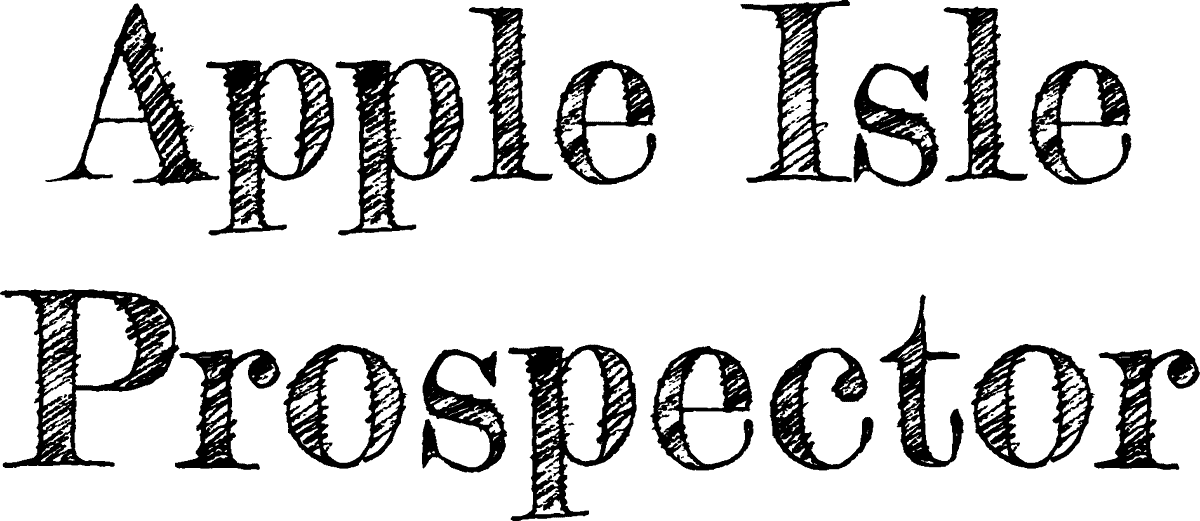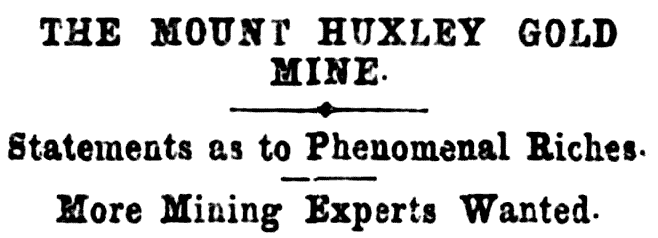Sometimes when I’m researching places to go prospecting or fossicking, I come across interesting anecdotes and stories that have fallen out memory. One of the best of these is the famous Mount Huxley swindle of 1894. But before I start: does anyone today remember the massive Bre-X gold mine scandal of the mid 1990s? At the time, the discovery in Borneo was being talked about as possibly one of the biggest gold mines in history. Then the fraud was discovered and the whole house of cards came crashing down. But did you know Tasmania had the exact same thing happen just over a century earlier?
In the heady gold-rush days of the 1890s, one particular discovery promised to be the biggest gold mine ever found: Mount Huxley, southeast of Queenstown, between Mount Owen and Mount Jukes. The show was reported as being so good as to threaten to depreciate the value of gold. Within a few short weeks, the Mount Huxley mine was exposed as a massive fraud.
West Coast gold: a quick history
After the first official discovery of gold in Tasmania, at Mangana, James ‘Philosopher’ Smith found coarse gold in the Forth River, in north-western Tasmania, in 1859. However, it wasn’t till he made his most famous discovery, the Mount Bischoff tin mine, that prospecting on the West Coast kicked off in earnest. In 1878, Harry Middleton and his companions were prospecting in the White and Savage Rivers area, near present-day Corinna, when they came across the first payable gold discovery on the coast, still today called Middletons Creek. The Pieman River goldfield would go on to produce the two largest gold nuggets ever found in Tasmania. On the 23rd of January 1883, McGinty and his partners were working the Rocky River about 1 km upstream from the Whyte, and found a 243-ounce nugget, the largest ever found in Tasmania. A week later they found a 39-ounce nugget. A separate party found a 140-ounce nugget a month later, the second-largest ever found in this State.
The same year that Harry Middleton discovered the first payable West Coast gold in Corinna, Lynch and company discovered gold in the Queen River near Queenstown. Since most of the fields in the Pieman were only rich enough to barely cover tucker, many prospectors moved to the Queenstown discoveries. From here they spread out, and in 1883 the Cooney brothers Bill and Mick McDonough discovered gold in the Linda valley, at a place known as the ‘Iron Blow’. This would go on to become the famous Mount Lyell Mine, still on and off in operation, and with a colorful history of its own that I’ll leave for another post.
As prospectors spread out of Queenstown, gold in various quantities was found in most of the creeks and rivers that drain the West Coast Range, including Mount Huxley. Eventually, over the years, the alluvial gold was exhausted, though the source of the gold in some of the creeks had been traced to a dyke of porphyry. In early 1894, the lease sold to a Sydney syndicate. Rumours and news of the developments did not stay off the papers for long.
The headlines were anything if not optimistic. A company was floated in Sydney, the share issue was oversubscribed (except in Tasmania, interestingly), and everyone wanted to be a part of the action (but not in Tasmania). The promoters and their experts were extremely enthusiastic, stating that the property contained “according to the lowest estimate of 5dwt of gold per ton, £20,000,000 worth sterling of gold”. Figures of as much as £150,000,000 worth of gold were bandied about, and widely reported. This was enough for the promoters to make statements that the output of the mine was likely to cause a depreciation of the value of gold after just a few years of operation. Meanwhile, back here in Tasmania, it sounds like most people in mining circles could probably smell the stink. That last link above shows that there was plenty of laughter at a public meeting in Hobart when the promoter described what they thought they’d found. Were they laughing from joy, or more likely because they thought the statements were just ridiculous, and the fraud was self-evident to outsiders? The promoters had trouble selling the shares they’d allocated to Tasmanians, and it was common knowledge that the property had been abandoned as exhausted years earlier. Other reports from the time show that many of the company’s statements were generally regarded by Tasmanians as being completely ridiculous. Rumour and innuendo had been going around since early that year, and the Wellington Times (Hobart) was openly skeptical about the find as early as the 22nd of May, describing Mt Huxley as a ‘Glaring Swindle’.
The gold fraud
It didn’t take long for the truth to start coming out. On the 6th of June, Alexander Montgomery, a young New Zealader who was Tasmania’s Government Geologist, released an explosive report on Mt Huxley in the Legislative Assembly. He concluded that the mine and the property generally had been ‘salted’ (spiked with gold to skew assay results), and that the salters had used alluvial gold, which is waterworn and easily distinguished different from ragged, crystalline reef gold.
I am sorry to say I have been driven to the conclusion that there has been foul play in connection with this mine, in fact, to use an expressive and well-understood mining phrase, that it has been ‘salted’.Alexander Montgomery, Government Geologist
The following day, reports of the fraud started to appear in the press. The promoters, undeterred, continued to promote the mine, producing their own experts to counter the Government Geologist’s report. Montgomery went back to Mount Huxley, this time with James Harrison, the west coast Inspector of Mines, based in Zeehan. This time they were much more careful to collect samples from various places, both from the surface, and also virgin samples after having scraped all the (potentially salted) surface rock out of the way. They found that samples collected after scraping the exposed rock out of the way were almost barren, whereas samples collected from the surface of the ground, inside the mine, always assayed highly for gold. The gold used in the salting was alluvial, and waterworn; by comparison the little gold recovered from the washed or subsurface samples was ragged and crystalline. The story was pretty clear, as their second report describes. Other reports quickly vindicated the Government Geologist.
The main perpetrator, a man named Isaac Bertram Barker, was arrested in Hobart on the 19th of June. It was reported that he had been buying up alluvial gold from prospectors in the area since early in the year. This seems to have been common knowledge in prospecting circles, perhaps accounting for Tasmanian’s reluctance to believe the promoter’s claims. Barker had gone to P. Samuel, who would eventually become the main promoter, with a bottle full of gold and conned him into purchasing the lease. Samuel was eventually driven bankrupt, and he admitted that he had been blinded by the bottle of gold (and probably his own greed), and seems to have been reluctant to believe what seems to have been pretty common knowledge in Tasmania. Two days after Barker’s arrest, William Price and Anthony Briscoe were also arrested in Strahan. They were the mine workers accused of actually sprinkling the gold around the mine and in collected samples. In the end, they were all released from lack of evidence, and as far as I’ve been able to find, nobody was ever tried or convicted for the infamous Mount Huxley swindle, the biggest gold fraud in Tasmania’s history.
Do you enjoy the more historical posts? Do you want to know more about this? Perhaps there’s a topic on Tasmanian mining history (or anything else) you’d like me to write about? If you like the content at Apple Isle Prospector, feel free to get in contact, or leave a comment.



